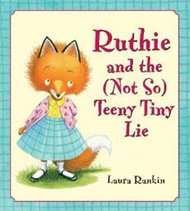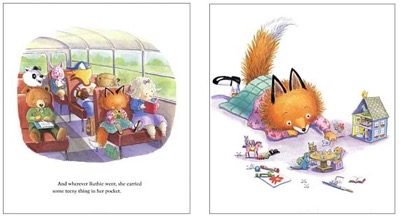Tiny Lies
February 18, 2016 01:07 PM Filed in: 40 Books


Book 6 of 40
Ruthie and the (Not So) Teeny Tiny Lie by Laura Rankin starts out with a sweet little fox who adores tiny things. She is always keeping her eye out for the tiniest of treasures, and she scores on the playground. When she finds a tiny camera, she is thrilled! However, when she learns that this camera already has an owner who was missing it, the situation becomes anything but tiny. The little fox lies about who the camera belongs to and she suffers the mental distress of knowing she has lied. She must sort out how to make things better before school the next day.
This is one of those books that discussion as you read is crucial. Ask questions as you read it the first time, and before you get to the end let your own tot decide whether the lie was right or wrong and how Ruthie should fix the situation. Children don't quite understand lies until they reach a minimum of age 3, but the utility of lying really kicks in around 4 or 5. Sometimes kids don't realize they are lying because they can't differentiate between how they really wanted things to happen and how they actually happened. In this case, it seems that Ruthie knew the difference immediately, yet struggled with how to come clean. What a great book to use to talk about the importance of being honest and having the courage to tell the truth!
While the focus of this book is on the actual lie itself, there are other lessons to be learned and fun to be had!
- Observe tiny creatures: You might need a magnifying glass, but head outside and see if you can find any ants or other tiny bugs and watch them for a few minutes. Talk about what they may be doing or where they may be going
- Go on a tiny treasure hunt: Inside or outside make a list of tiny things you may find or look for a list of shapes but they all have to be a on tiny things i.e. hearts on a clover or ovals on a flower petal. You could even avoid the list all together and see what bits and pieces you can find laying around outside. Remember to stay close to your tot as she is searching because we know how tots like to explore with all their senses, including taste!
- Make a bite-size meal: Grab some pre-made frozen items or make your own, but enjoy whatever tiny food your little heart desires! Mini pancakes, mini waffles, mini quiches, mini muffins, mini hotdogs, mini tacos, mini grilled cheese, mini burgers…
- Let your tot play photographer: Help your tot use your camera or camera phone to snap shots of what she sees. Alternatively you can craft a matchbox camera and write down or draw what she sees.
- Make a tiny photobook or craft: If you let your tot take some pictures, consider making a tiny photobook with those photos. If you didn't let your tot play photographer, you can still curate your own photos for a tiny photobook. Or look at my pinterest board and choose a tiny craft to do :)
- Talk about the idea of "finders keepers": Just because Ruthie found the tiny camera, does that mean it should be hers? What if you find something at the park, do you get to keep it and take it home because you found it? What would you want someone who found your toy at the park to do?
- Role play the conflict between Martin and Ruthie and discuss better options: Could Martin have said something better than "Hey, that's my camera!"? Could Ruthie have said something better to Martin instead of "No it's not, it's mine!"? What could they have done to not get so mad at each other?
- Draw a picture of how lying makes you feel: How does your face feel? How does your heart feel? How does your tummy feel?
- Do an object lesson on lying: There is the salt on the ice cream option or an option using quarters, water, and pennies
- Define courage: What was Ruthie afraid of that she had to have courage to do? What do you need courage to do?